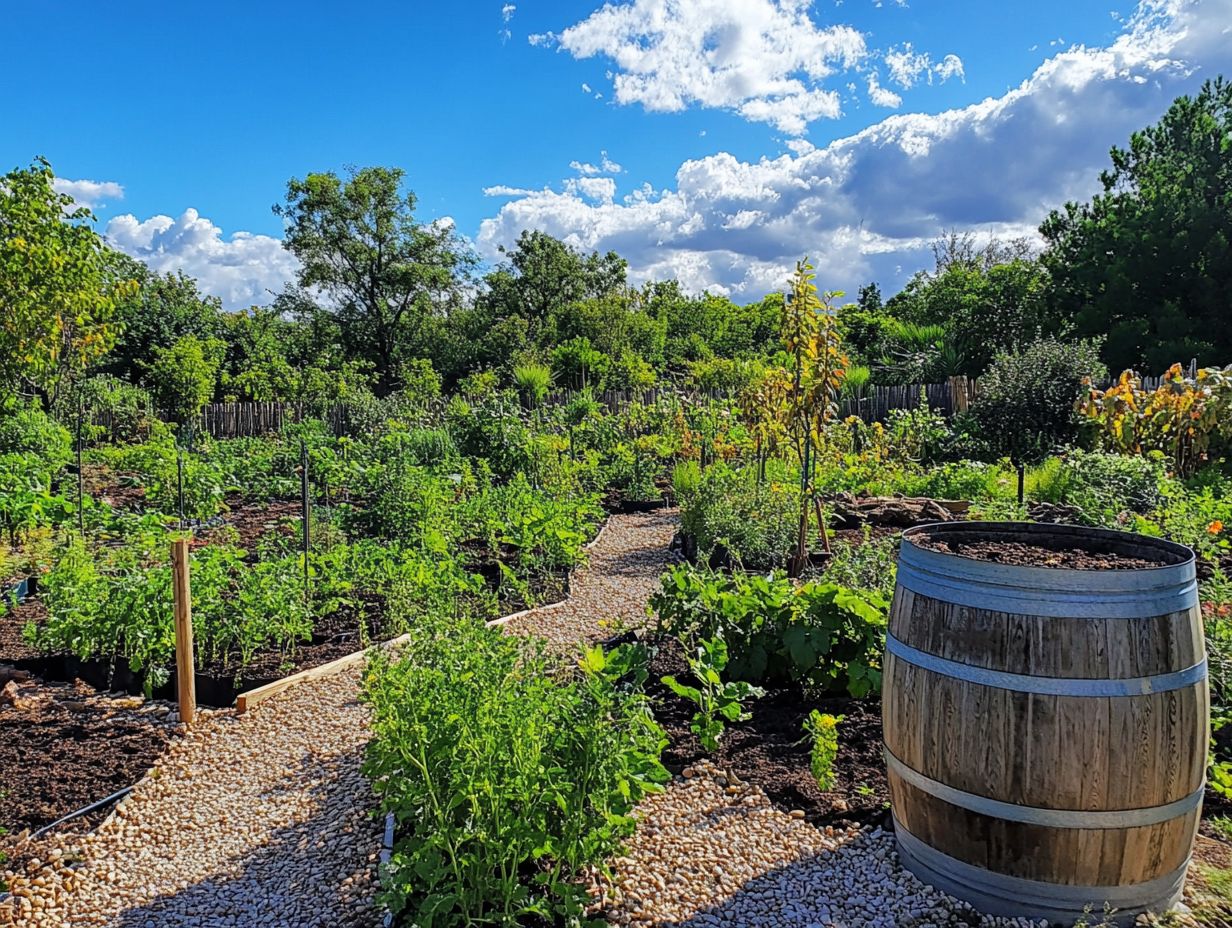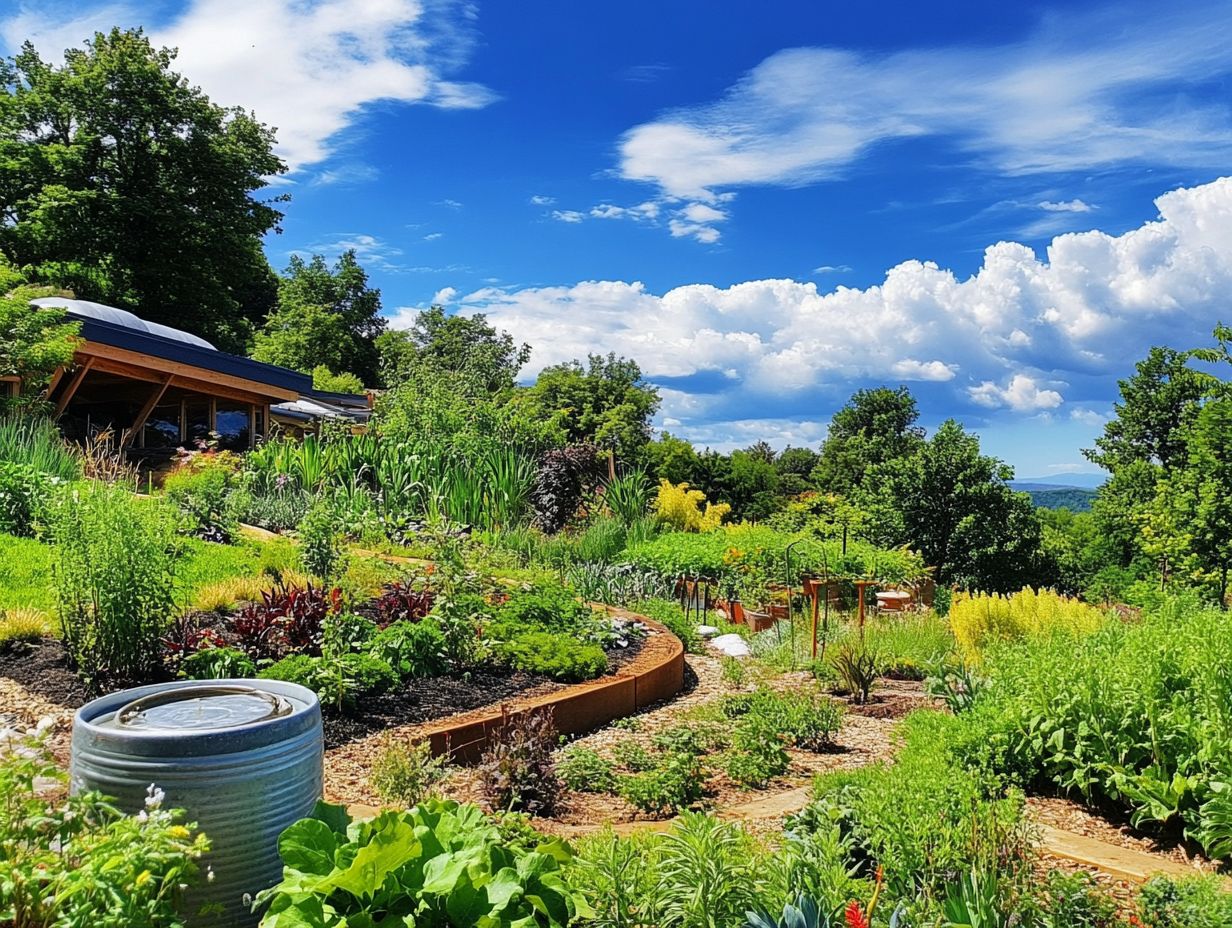Exploring Water Harvesting in Permaculture Design
Water harvesting is an essential practice that captures and utilizes natural water resources, significantly contributing to sustainable living, particularly within the realm of permaculture design.
This article defines water harvesting and delves into its various techniques, including rainwater, greywater, and condensation harvesting.
You will find a discussion on the environmental and financial benefits these systems provide, alongside guidance on effective implementation and an overview of common challenges you may encounter.
Explore the transformative potential of water harvesting and see how it can help you create resilient ecosystems.
Contents
Key Takeaways:

- Water harvesting is the practice of collecting and storing rainwater, greywater, and condensation for later use in permaculture design.
- Implementing water harvesting techniques in permaculture design not only has environmental benefits but can also save money in the long run.
- Proper planning and design, as well as addressing common challenges, are key to successfully implementing water harvesting in permaculture design.
What is Water Harvesting?
Water harvesting is an innovative technique designed to collect and store rainwater for various applications. It plays a crucial role in sustainable living and environmental stewardship.
By capturing rainwater from surfaces like rooftops, you not only contribute to water conservation but also enhance groundwater recharge. This practice supercharges how we manage water resources!
Definition and Purpose
The purpose of water harvesting is to efficiently collect and utilize rainwater or other sources, an important way to resource conservation and environmental sustainability.
This practice includes many methods, from rooftop collection and surface runoff capture to innovative soil moisture conservation techniques. By embracing these strategies, you can significantly enhance the ecological balance within your community!
Water harvesting not only bolsters agriculture by providing essential irrigation but also aids in groundwater recharge, contributing to healthier local environments. By aligning with the principles of sustainable living, this approach gives you and your community the power to take proactive steps in safeguarding water resources, fostering a deep sense of responsibility toward nature, and ensuring a steady supply for future generations.
Types of Water Harvesting Techniques
You have access to a variety of water harvesting techniques that can enhance your water management and conservation efforts.
Among these methods are rainwater harvesting, greywater harvesting, and condensation harvesting, each crafted to optimize water usage and champion sustainable practices.
Rainwater Harvesting
Rainwater harvesting is all about collecting and storing rainwater from your rooftops and other surfaces using systems like rain barrels. This practice can significantly enhance groundwater recharge and bolster urban greening efforts.
Embracing this approach not only contributes to the sustainability of your residential space but also supports agricultural systems by offering a dependable water source, especially during those dry spells. By employing techniques such as shaping the land to help collect water and a system that delivers water directly to the roots of plants, you can optimize water usage while promoting soil moisture retention.
Integrating rooftop gardens into your rainwater harvesting strategy can amplify the benefits even further. It allows you to grow your own food and cultivate greenery while minimizing runoff. By adopting best practices such as regularly maintaining your collection systems and utilizing effective filtration processes you ensure that the harvested rainwater remains clean and suitable for irrigation.
This commitment ultimately fosters environmental responsibility and enhances biodiversity in both urban and rural settings.
Greywater Harvesting

Greywater harvesting involves collecting and reusing wastewater from sinks, showers, and washing machines. This allows you to participate in water conservation through eco-friendly techniques.
This innovative approach eases the strain on freshwater supplies. It also fosters sustainable living practices.
By redirecting water that would typically go down the drain, you can significantly reduce your overall water consumption. You can also lower your utility bills.
The advantages of greywater harvesting go beyond just savings; it s a vital element in systems that manage water efficiently. It provides eco-friendly irrigation options for your gardens and landscapes.
However, implementing these systems can present challenges, such as navigating local regulations, ensuring proper treatment methods, and raising public awareness about correct usage.
Embracing greywater harvesting positions you as a key player in resource conservation efforts.
Condensation Harvesting
Condensation harvesting stands as an innovative method that captures water vapor from the air. It provides a unique solution for water cycling and moisture retention in arid regions.
This technology cools air to its dew point, which is the temperature at which air becomes saturated and water vapor condenses. This allows moisture to condense and collect, showcasing remarkable effectiveness in areas where traditional water sources are scarce.
In dry deserts or coastal regions, this adaptive approach not only replenishes local water supplies. It also plays a vital role in promoting eco-conscious practices.
As communities increasingly prioritize sustainability, the versatility of condensation harvesting offers promising potential. It aids in the reestablishment of native vegetation and biodiversity elements essential for maintaining ecological balance.
Benefits of Water Harvesting in Permaculture Design
Water harvesting in permaculture design offers a variety of benefits that extend beyond mere convenience, especially when you consider understanding the water cycle in permaculture.
You ll find enhanced environmental sustainability, improved water allocation, and even the potential for financial savings.
This makes it an essential component of contemporary sustainable practices. You not only meet your needs but also contribute positively to the ecosystem.
Environmental Benefits
The environmental benefits of water harvesting are substantial. They offer you improved soil fertility, erosion control, and the creation of micro-habitats.
These practices increase soil moisture retention. This is vital for sustaining plant growth, especially during those dry spells.
By capturing and storing rainwater, you can ensure that ecosystems enjoy a more consistent water supply. This supports diverse flora and fauna.
Urban greening initiatives, like installing rain gardens and permeable pavements, elevate the aesthetic appeal of your surroundings. They also effectively mitigate surface runoff.
This leads to a reduction in urban heat islands and fosters healthier urban ecosystems. It creates a harmonious environment for both wildlife and city residents.
Financial Benefits
The financial benefits of water harvesting yield significant cost savings. This translates into reduced water bills, improved resource conservation, and more efficient water allocation.
These advantages enhance your cash flow by lowering household expenses. They also promote sustainable agricultural practices, ensuring the long-term viability of your farming endeavors.
By capturing and utilizing rainwater, you can decrease your dependence on municipal supplies. This helps to stabilize local economies against the rising costs of water.
Investing in water harvesting infrastructure can lead to enhanced crop yields and better-quality produce. This increases your income potential as a farmer.
Ultimately, the economic advantages of such systems extend far beyond mere savings. They foster resilience during droughts and support broader efforts toward environmental sustainability.
Implementing Water Harvesting in Permaculture Design

Implementing water harvesting in your permaculture design requires careful planning and consideration of various factors. Understanding the significance of water in permaculture design ensures that eco-friendly practices are integrated into your system, enhancing sustainability and efficiency.
Factors to Consider
When designing a water harvesting system, consider critical factors such as local climate, available water resources, and community initiatives that highlight the importance of water in permaculture systems to promote environmental sustainability.
Understand the unique climatic conditions in your area. Variations in rainfall patterns will directly influence the effectiveness of your system. By leveraging local resources like soil composition and native vegetation you can significantly enhance water retention and usability.
Engage your community during planning and implementation to foster ownership and encourage knowledge-sharing. This collaboration leads to innovative solutions tailored to regional challenges. By prioritizing these elements, you can create sustainable practices that conserve water and strengthen the ecosystem’s resilience, benefiting both present and future generations.
Designing a Water Harvesting System
Designing a water harvesting system, whether incorporating rain barrels or using methods to manage water flow in landscapes, requires a nuanced understanding of your local environment and careful selection of eco-friendly techniques, such as those outlined in how to manage water in a permaculture garden.
Analyze seasonal rainfall patterns, soil types, and topography to implement the most effective methods. For example, integrating swales and permeable surfaces can significantly enhance infiltration and manage runoff effectively. Embrace innovative technologies, such as smart irrigation systems, to optimize water use.
The materials you choose whether recycled pipes or locally sourced biopolymers play a crucial role in minimizing environmental impact. By considering your community’s needs and raising awareness about sustainable practices, you ensure that your water harvesting system is both practical and beneficial in the long run.
Common Challenges and Solutions
You may face common challenges in water harvesting systems, such as maintenance concerns, efficiency hurdles, and community acceptance issues. However, these obstacles can be tackled with innovative practices and well-thought-out solutions.
Addressing Common Issues
Addressing challenges in water harvesting requires effective maintenance strategies and enhanced system efficiency through innovative methods.
For long-term success, regularly monitor your systems to ensure components like filters and storage tanks are clean and functioning optimally. Utilize automated sensors and smart water management technologies to boost functionality, reducing the need for manual labor.
Foster community involvement through educational workshops. This empowers local stakeholders to adopt sustainable practices, creating a more resilient approach to water conservation. These strategies not only lighten your maintenance load but also promote efficient resource use, yielding substantial benefits for both the environment and society.
Frequently Asked Questions

What is water harvesting in permaculture design?
Water harvesting in permaculture design refers to the collection, storage, and reuse of rainwater or other water sources on a permaculture site. It involves creating systems that conserve water resources and optimize available water for sustainable agriculture and ecosystem management.
Why is Water Harvesting Important in Permaculture Design?
Water harvesting is crucial for sustainable living. Techniques like rainwater harvesting conserve resources and reduce reliance on external irrigation, helping systems withstand droughts.
What Techniques Are Used for Water Harvesting?
Common techniques include swales (or shallow trenches), raised berms, contouring, mulching, and rain barrels. These methods capture rainwater, allowing it to soak into the soil for later plant use.
How Does Water Harvesting Benefit Plants?
This practice provides plants with a reliable water source, even during droughts. It boosts soil moisture and reduces erosion, fostering a healthier growing environment.
Can Water Harvesting Be Done in Any Climate?
Absolutely! While techniques may vary, water harvesting suits all climates. In dry areas, focus on capturing rainwater; in wetter regions, manage runoff and prevent erosion.
Is Water Harvesting Cost-Effective?
Yes, it s a smart investment that pays off! Although initial costs exist, savings from lower water bills and better crop yields make it worthwhile.






